

Welcome to our first digital newsletter! In our new era of physical distancing, it seems appropriate that VMSG joins the 21st Century for fast electronic communication. Hopefully, as we all bed in to this new regime, our re-vitalised communication tools will help us all stay socially-connected. We hope you have been enjoying the new website too. You can also find us on Twitter (@vmsg_uk), Facebook and Instagram.
This edition brings a look back to the heady crazy times of of the Annual VMSG meeting where we were all able to meet in a room together and share science and socialise. It was a great meeting! By coincidence this edition’s volunteered contributions had a strong flavour around volcano outreach, so I solicited more ‘outreach’ themed contributions and this is what we have! Issue no. 45: the ‘Outreach’ Special.
Hopefully some inspiration here for connected times ahead, but also some sources of digital materials to share with those currently experiencing the joys of home-schooling. Watch out soon for some more virtual VMSG Community activities!
Stay safe!
Jenni
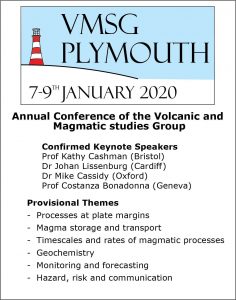
Some 140 delegates gathered in Plymouth from the 7th-9th of January for our Annual Meeting. We had a wide range of topics that broadly reflected our communities interests and that of the Plymouth VMSG group, from hazards, risk and communication to timescales and rates of magmatic processes. There was also the inception of the ‘Early Careers Research’ Forum to go along with the forum for students and research students. Speaking of which we managed our usual good balance of research students, as illustrated by Sam Engwell’s graphic. Sam is the ‘Equality and Diversity’ Officer for the VMSG Committee and will be reporting on some more analysis she has done in the near future.
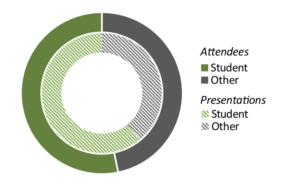
Balance of student and other presenters and delegates at VMSG 2020. Graphic: Sam Engwell
Of course, the student talks and posters as well as being numerous were fantastic examples of how to present well! Engaging, clear and, in the case of the talks, on time! So, judging the best posters and talks was very tough but here they are!
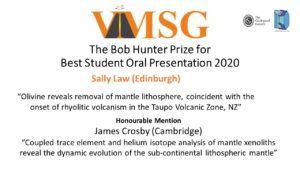

In addition to this we also had some exciting keynote presentations as well as the VMSG Prize Talk from David Pyle (Oxford University). Congratulations again to him!
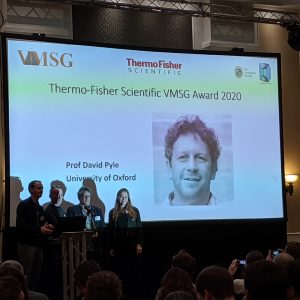
Photo from @RebeccaPaisley9
A few other photos and snippets from Twitter during the meeting. Big thanks to Paul Cole, Michelle Harris and Irene Manzella for all your organising skills – it was a fantastic meeting! Thank you also to Iain Stewart who gave a very successful public lecture.
Finally, next year’s VMSG (which could be VERY EXCITING INDEED IF WE ARE ALL OUT AND ABOUT) will be hosted by the team at Manchester University.
As a first-timer at Goldschmidt, I arrived at the conference filled with anticipation, excitement, and most of all: nerves! But even from the Icebreaker evening I could spot many familiar faces, people I have met over my years as an Undergraduate back in Chile, and later from collaborations and friendly chats at conferences such as VMSG and GGRiP during my time as a PhD student here in the UK, that made me feel part of it already. The last Goldschmidt introduced a new modality of presentation for people that, like me, asked for oral presentations but were not able to be allocated one at highly solicited sessions: a flash-talk, that allowed in 4 minutes to briefly present the highlights of their research and advertise their poster.
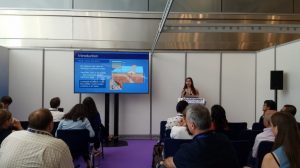
Goldschmidt 2019 Flash Talks. Photo: Rebeca Lopez-Adams
I presented some of the work of my PhD with the title ‘Tracing subduction zone fluids in the Izu arc using molybdenum isotopes’ in the session: Subduction zones and associated fluid and mass-transfer processes. With my flash talk on Wednesday morning and my poster session on Wednesday evening, I was fortunate to have enough time during the first days of the conference to get familiar with the setting, practise my presentation and make use of every small break to catch up with colleagues and invite them to my presentation. As a result, my flash-talk had a great turnout, I received very good comments and many people that had not seen my work before came to my poster later. After my talk, I even had the chance to talk about possible job offers, which as a final-year PhD student is exactly what I was looking for! At the poster session I had some interesting chats and discussed my work from new perspectives, got very positive feedback about my data and my models, made some new contacts and strengthened connections I previously had.
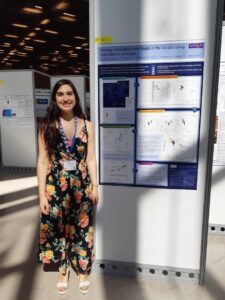
Goldschmidt 2019 Poster Presentation: Photo: Rebeca Lopez-Adams
Aside from my own presentation, I really enjoyed hearing the talks in the so many different sessions at the conference – from isotope geochemistry to astrobiology, subduction zones to core formation, economic geology to carbon sequestration. I was amazed by the amount, variety and quality of the science presented at Goldschmidt, and it was often hard to decide which session to attend as there were many interesting ones happening at the same time. It was an enlightening and inspiring experience for sure, and very successful in terms of networking, receiving feedback and broadcasting my work, which I am happy to have been able to take part in and I am sure will have a positive impact in my career.
(1) Diffusion in Minerals, Rocks and Melts: Potential and Pitfalls
October 23rd 2020
Burlington House, London
This meeting, intended to be the first of a new series, will review recent work in diffusion modelling and its application to a range of geological problems. How good (or not) can models be? What are the limits of what can be stated from our models? What are the pitfalls? It is intended to appeal to those interested in applying diffusion modelling to problems of rates, timing and thermal history in a wide range of mineralogical contexts.
The meeting will be led by a series of invited speakers who will address the fundamentals of diffusion theory and its application to modelling geological processes, and provide examples of state-of-the-art research on diffusions in various contexts. These will be followed by a Poster session, primarily for Student Poster presentations, with 90 second nano-introductions to each poster. The proceedings will conclude with a panel discussion.
We will hold one-day short course on diffusion modelling on October 22nd, and details will be made available as soon as possible.
For up-to-date information check the Mineralogical Society web site at https://www.minersoc.org/diffusion.html
The meeting is supported by: The Applied Mineralogy Group & The Metamorphic Studies Group as well as VMSG!
(contributed by Tamsin Mather)
Funded by the Royal Society, Your Science Out There is a collaboration between myself, the Oxford Sparks outreach portal and 3 amazing Earth Sciences PhD students to develop a series of videos and teaching resources. Our aim is to share our excitement about pushing the frontiers of science to understand planetary-scale processes and to show students that the concepts that they are learning at school (or beyond!) are used daily by researchers at the knowledge frontier. The classroom resources have been developed in collaboration with education specialists and link these Earth Science topics into key areas of the Chemistry and Physics schools curriculum. We hope that this will arm teachers with exciting material opening new horizons in student perception of where science can take you and the possibilities of studying Earth and Environmental Sciences. We particularly hope that they VMSG community will enjoy Anna Brookfield’s video showcasing her volcano science. If you like the site then please spread the word!
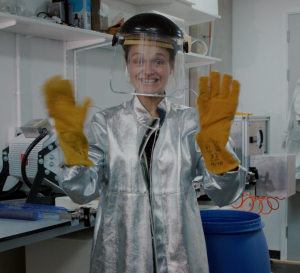

Contributed by Marissa Lo
Along with John Pernet-Fisher, Tom Harvey, Ricci Bahia, and Elliot Carter, I’ve been working on a podcast for the Isotope Geochemistry and Cosmochemistry research group, here at the University of Manchester. On The Cosmic Cast, we talk to researchers, from PhD to professor level, about their research and their career path. So far, we’ve spoken to a few members of the VMSG community, such as: igneous petrologists, David Neave and Emma Waters; atmospheric volcanologist, Cat Hayer; and remote sensing researchers, Matthew Varnam and Ben Esse. The podcast is pitched at undergraduate level, but is aimed at anyone who is keen to learn more about Earth and planetary science. Through the podcast, we’re hoping to help people understand the diverse range of topics that exist in Earth sciences and to make science seem more accessible! Please give us a listen and if you’d like to be a guest on a future episode, please get in touch with me at marissa.lo@manchester.ac.uk.
You can find all of the podcast episodes on our YouTube channel or on Spotify.
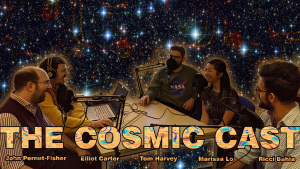
Contributed by Natasha Dowey
VMSG member Natasha Dowey has recently launched a new website called “Geoscience for the Future” (www.geoscienceforthefuture.com). It aims to reframe how we talk about geoscience and improve public perceptions of the topic, by showcasing research and careers that contribute to a more sustainable future. The site will host blogs from contributors working across the spectrum of geoscience- upcoming articles include industrial waste for carbon capture, engineering for landslide hazard mitigation, and mixing science with storytelling. We will also be hosting blogs about diversity issues in geoscience. We’d love to have some engaging stories from volcanologists- if any VMSG members would like to contribute to the site, please see the blog guidelines here and feel free to get in touch with Natasha on N.J.Dowey@hull.ac.uk.
contributed by Jenni Barclay
In these locked down times you might find some ideas and inspiration for home experiments with simple household objects from the UEA Volcano Outreach resources page. More material will be added throughout this period from our considerable backlog of happenings!
You may also have spotted a well-known volcano-influencer Janine Krippner (Smithsonian GVP) has been hosting some Volcano Moments on Youtube, also featuring some well known VMSG members!
Contributed by Emma Waters
In July 2019 the Manchester Volcanology group attended Bluedot Festival along with the Earth and Solar System Outreach team. Bluedot is a music festival based at Jodrell Bank Observatory which runs every year. Along with the music the festival runs science events during the day including talks, shows, workshops and stalls. The event attracts all kinds of music and science fans and is family-friendly so all ages of visitors attend. Every year the E&SS group run a stall at the festival promoting planetary science through interaction with meteorite hand samples and a ‘meteorite hunt game’. Over the past few years we have run pop-up volcano shows alongside the stall which have involved some sticky golden syrup lava experiments and the ever favourite Coke and Mentos eruption. This year we were set a challenge by the organisers to turn this into a 30 minute science show on one of the stages!
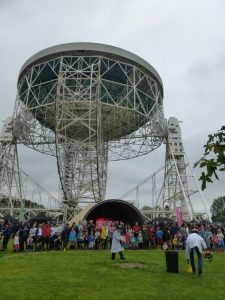
Getting to work we translated our pop-up show to a stage show. Using a presentation and interactive experiments we explained convection in the mantle, where volcanoes are found and why, different viscosities of lavas (golden syrup on its own and mixed with sprinkles/marshmallows) and effusive (bicarbonate soda and vinegar) vs. explosive eruptions (Coke & Mentos).
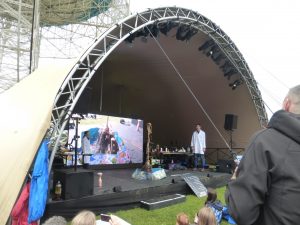
The finale was our trashcano, something we decided to bring in for the show specially. This involved a lot of work testing outside the department to get the technique down and thankfully on the day it went off with a good bang. Things learned from trashcano: 1. To gather an Earth Science department email to say there will be a trashcano testing at a specific time and not to be alarmed by a bang. 2. Get a strong bin. 3. If using rubber ducks as projectiles they will be stolen by exited 5 year olds.
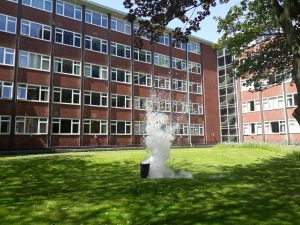
Reflecting on the change to a bigger, advertised show we certainly attracted much higher numbers than in previous years. We estimate the audience size that watched the entire show was around 100 people. Others who came in late or passed by at the end asked if we would be on again so they could come back and watch. Having the use of a screen and more time meant we could explain more of the theory and importantly explain what volcanologists do and why it is important. With the large age range captured this was an excellent opportunity to bring the field into the public eye. At the end we provided information on where people could find out more about volcanoes and careers within geology and volcanology. Following the show we had many visitors come with follow-up questions, either from what we had said or general volcano questions. ‘Volcanoes: What makes them go bang?’ was very well received and we have been invited back again this year with potential for multiple shows over the weekend. As a group we hope to continue running this new outreach activity for as long as there are people to support it, having seen how it enthuses the public about a subject which is sadly being less frequently taught in UK schools.
Contributed by Richard A. Batchelor, Chairman, geoHeritage Fife, Honorary Research Fellow, Earth & Environmental Sciences, University of St. Andrews
In Scotland’s East Neuk of Fife, numerous volcanic necks of late-Carboniferous age have punched through Lower Carboniferous sedimentary sequences. The volcanism is of alkali mafic to undersaturated mafic compositions. Locally they form spectacular coastal scenery such as at the Rock and Spindle near St. Andrews.
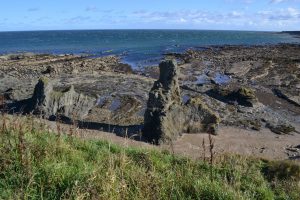
While this locality is used by specialist groups and students to study the dynamics of late-Carboniferous volcanism, it is important that access is relatively easy in order to bring the volcanic necks to the attention of the general public. One such location is the exposed neck at Elie Harbour.
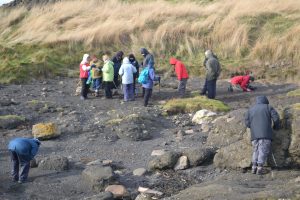
This site has been selected by geoHeritage Fife, a local geodiversity charity, to form the basis of a geological trail leaflet. Work on it has been undertaken by Richard Batchelor, (Chair), Rosalind Garton (Secretary) and University of St. Andrews geology undergraduate, Rebecca Bateman. “Proof-walking” by geoHeritage Fife members makes sure that the leaflets are easy to understand for the non-geologist.
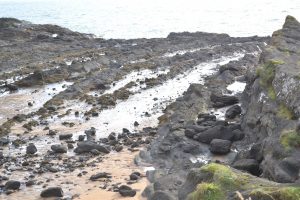
Concentrically dipping beds of basaltic tuff show where the cauldron collapsed inwards. In the tuff are blocks of basalt from previous eruptions, some plucked by hot ash and gases on their way up while others may have fallen back into the vent.
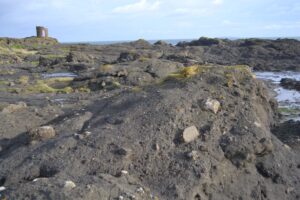
A large block of sandstone is welded to the tuff below. As the volcanic cauldron collapsed, substantial fragments of the surrounding Carboniferous sediments rock fell in and became part of the neck.
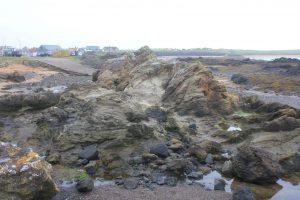
Contributed by Jenni Barclay
After the final day of VMSG 2020, some 30 or so hardy souls set off on a ‘hero’s journey'(*) to learn some more about the art and science of storytelling with Iain Stewart and Jenni Barclay. The group were able to discuss how this technique can not only helps scientists connect with their intended audience, but that they can also be mined for information about some of the interactions and impacts of risky situations. Finally, the process or act of coming together to share stories can improve how we understand and share information.
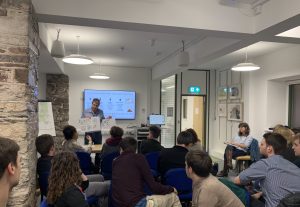
As if to prove the value of shared stories the group used the final exercise (to put into practice some of the elements talked about in the presentations) to come up with a triumphant idea. They wanted to battle common misconceptions about volcanic activity and its vagaries through a proposed series of children’s books designed to explore several iconic eruptions using the important elements of a good story. Publishers form an orderly queue here please(**)! The resultant stories ranged from a cat-rescuing, precursory earthquake recognising Minoan girl, to a lava-tube and time travelling visitor to the 122 B.C. Plinian eruption of Etna. On the way home we used the travel time to come up with lyrics that conveyed the uncertainty of volcanic eruptions via the #volcanohero
There once was a young girl called Margot, Who lived happily on a volcano, One day she felt quakes, The town started to shake, So she roused the villagers and said “let’s go!” @drnatashadowey
There once was a volcano, who got all grumpy, his caldera was all short and stumpy, Some gases were farted, But eruption never started And his caldera just got even more lumpy @volcanojenni
There was once an active caldera, Whose emissions made scientists fear a Sudden fiery outburst, They awaited the worst, While others wished signs would be clearer @ailsanaismith
Sulphur dioxide beginning to gout led one keen observer to shout “Magma has got quite shallow, This volcano’s not fallow! Now might be a good time to get out!” @OrbitalPete
An edifice ready to blow, Tilted at letting us know, Tremor harmonic (Percussion chthonic) And animals fleeing not slow. @VolColMac
There was a volcano named Etna Who said “Am I active? You betcha! If my summit starts blowing And lava starts flowing Look out cos I’m coming to get ya! @elle_emm_cee
(*) if you don’t know about the hero’s journey you should have come
(**) not kidding(***)
(***) yes, I know asterisks are not a top story-telling tool!
Aaaaaaaand…..finally here is someone who has made his publishing dreams a reality, if you need to relax with a bit of apocalypse.
Bill McGuire (last Chair of VSG; first chair of VMSG) has a novel coming out in September this year. SKYSEED is an environmental thriller about geoengineering gone wrong. It also features a key role for Bolivia’s Uturuncu volcano. Pre-order on Amazon UK from the end of June.